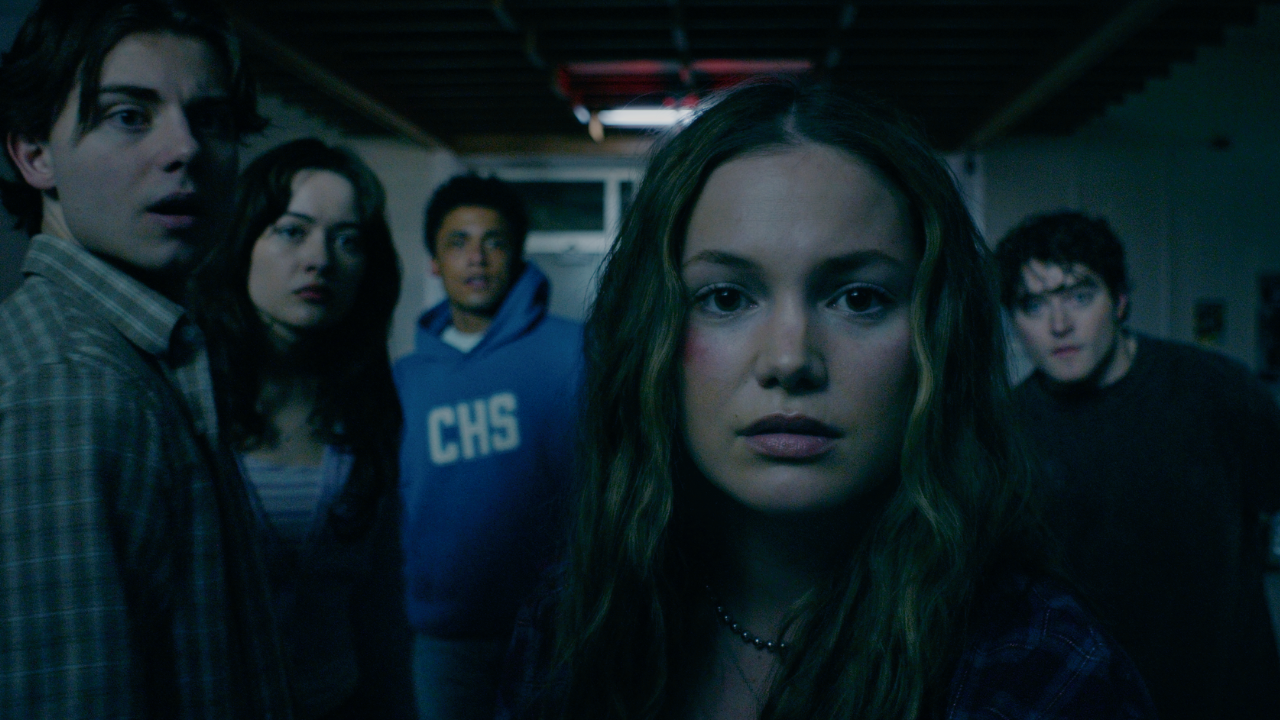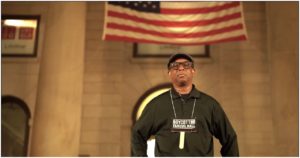If you haven’t noticed, zombies are having a moment. With titles like Queens of the Dead, 28 Years Later, and We Bury the Dead shaking things up this year, it’s hard to ignore that the undead are booked and busy. Which is why it’s good to know this trend will spill into next year with Adam Macdonald’s This Is Not a Test. The film, adapted from Courtney Summers’ book of the same name, follows a small group of teens as they attempt to survive a zombie apocalypse.
We caught up with Macdonald at the World Premiere of his new film to talk about zombies, 1990s music, and what drew him to this specific YA horror story.
Dread Central: You explained in the Q&A that this is an adaptation of This Is Not a Test by Courtney Summers. This is one of the many differences between this and your previous films (Backcountry and Pyewacket). What was the adaptation process like for you?
Adam Macdonald: I really enjoyed it because I already had the spark of inspiration and the road map from Courtney’s book. The outline of a project can take longer than writing the script. You need to break down all those beats, break the story down, go with your gut, and have it all make sense. Courtney gave me such a fantastic starting point and left me room to explore within that frame, which I found rewarding. There are elements they only talk about in the novel that I wanted to bring to life in the film.
DC: What’s one piece of advice you’d give to filmmakers thinking about adapting a novel for the screen now that you’re on the other side?
AM: Free yourself to explore while always keeping the author’s intentions and themes intact. As similar as novels and films can be, they’re still very different forms of storytelling. The book is written as an inner monologue, which can be a challenge to adapt to the screen. Many use voiceover as a tool for this, but I’m a big believer in show, don’t tell as much as possible. I would send Courtney every draft. I wanted her feedback, which was important to me.
DC: In the Q&A, you also mentioned that the character of Sloane (played by Olivia Holt) is what pulled you into the book. What do you think it was about her that made you want to follow her on her journey? And more importantly, want to transfer it to the big screen?
AM: I was immediately drawn to the book because I related to her deeply. I went through a very rough period in my life when I was in my teens, and I was compelled to tell this story as a love letter to teenagers to never lose hope. I saw that in the book and in Sloane, and I had to tell this story. It wasn’t a simple one-dimensional easy read that I thought it might be; it surprised me and moved me, and I hope to pass that on to the audience.
DC: You mentioned the book doesn’t specify when the story is set, but you felt it was the ’90s. You were also able to draw on that because you were these kids’ age at that time. Were there other things in the book that were left open to interpretation that you made a concrete choice about in the film? Or vice versa?
AM: Every step in writing the script and even re-reading the book a couple of times, I thought it was set in the 90s! I was shocked to eventually realize it wasn’t. To be honest, I might have projected my past on it because of what I went through. After releasing this, I did make a very clear decision to follow my gut and set the film in the 90s.
DC: You do a lot of horror, but this is the first time I’ve seen you helm a zombie apocalypse moment. Are you a fan of zombie films? Were there any zombie movies, books, etc., that you reached for outside of the source material when working on the script? If so, what were they?
AM: I absolutely LOVE zombie films, always have, really. There is something so eerie and unsettling about the very idea of the undead and or an infected horde coming for you. When I was six years old, I saw my first zombie in Michael Jackson’s Thriller, and it scared the shit out of me. It truly terrified me and then well…I couldn’t get enough. When Danny Boyle and Alex Garland “resurrected” the idea in 28 Days Later with the infected runners, I was blown away. I was first in line the day of the release.
If I had to pick a sub-genre in horror as a favorite, it would be the zombie film. I leaned into the runners in This Is Not a Test because they are depicted this way in the book, plus I find these types to be the most terrifying. The First 10 minutes of 28 Weeks Later is one of the greatest openings to a film ever, in my opinion. That film was a big source of inspiration, as well as The Horde and The Sadness.
DC: Zombies are kind of having a little renaissance. What do you think it is about the undead that keeps us coming back for more?
AM: I believe they are the perfect backdrop as a metaphor for what we go through, either as individuals or a community, be it pandemics, political collapse, consumerism…like Dawn of the Dead or, in this case, depression. They capture our imagination because they ARE US. Not really a monster, not the devil or a demon, which are great, but they’re US gone wrong. Just so much to express there.
DC: Because most of your cast were newly born in the era This Is Not a Test is set in, did you have to assign homework? If so, what movies, TV, music, etc. did you encourage them to check out when finding their characters?
AM: The one film I asked some of the cast to watch was Super Dark Times, for its authenticity and tone. I sent Olivia a lot of ’90s grunge and metal music to help set the mood. Because she and her sister are into bands like Deftones, Coal Chamber, and Megadeth. I sent her the Garbage music video Vow and Loco by Coal Chamber. It was so great that some of these bands let us use their t-shirts and posters from back in the day.
DC: One of the things that struck me as an audience member was the way the violence is handled. It’s still a bloody good time, but it feels like This Is Not a Test is more focused on the emotional impact of the blows than the blood splatter. It is such a cool way to follow these character arcs and witness their points of no return. Could you talk about how you made the choice to focus more on the weight of the violence than the acts themselves?
AM: Violence has consequences. It causes trauma, both visible and what you can’t see on the surface. Sloane is forced to deal with this at home or brutally on the crazy streets with these infected zombies looking to tear her world apart. I wanted the hit of a bat swing or a verbal assault to have an impact as it would in life, and not make light of it, so that we feel the weight that Sloane is carrying.
AM: These moments were clearly defined in Courtney’s book, and I knew how important they were to keep intact while in the edit. But honestly, I wasn’t sure at first, but after some feedback, it was clear we had to keep them in the film for the very reason you mentioned. They’re trying to find a way…they’re trying so hard to just be teens, but the world keeps interrupting.
DC: You have a pretty amazing cast with Olivia Holt, Froy Gutierrez, Corteon Moore, Carson MacCormac, and Chloe Avakian. How did you luck into so many established favorites? I was delighted to see you and Corteon Moore working together again. Were any of these actors in mind when you were working on the script?
AM: The producer Cybil Lui really went out there and generated some interest with the script. She proposed Froy and Luke, and I fell in love with the idea. Cybil was a rock star in helping cast this film. Olivia’s material came across my desk from her agency, and I knew her immediately from Totally Killer and Cruel Summer. It’s so funny because when I saw her in Totally Killer, I was so struck by her talent, and I thought at the time, that’s someone I would love to work with. She has such a presence on screen, and crazy enough, in less than a year, we were working together.
When I was writing the script, Corteon kept popping into my head. I absolutely loved working with him on Slasher: Flesh & Blood. I knew he had the gravitas to play someone like Cary, and I was so grateful he did. And of course, Jeff Roop as Sloan’s father, the last time we worked in a film together was in Backcountry. It was great to work with him again. I’m so proud of the cast. Carson, Chloe, Joelle, and Krista just inspired me so much every single day.
DC: What’s one thing you’ve been dying to talk about regarding this movie (non-spoilers obviously) and haven’t been able to? Please spill.
AM: Lee Malia’s score, I feel, is the best he’s done with me. He’s such a talent; he comes from a very successful band, so he brings all these unique, fresh takes that a traditional film composer might not do. He surprised me in the best way. It’s very special what he has done. He truly elevates the material; I’m very grateful to him.
DC: What’s next for you after This Is Not a Test?
AM: I have a couple of projects percolating that I’m very excited about, but I just can’t say anything…yet.
DC: Where can people follow you online (if you would like to be followed) to keep up with your work?
AM: IG is where you can find me @_adammacdonald.
This Is Not a Test just had its world premiere at Brooklyn Horror Film Fest. It was also recently acquired by IFC and Shudder and is set to release in theaters in 2026.
Categorized: Interviews







